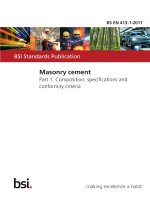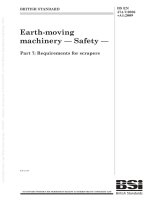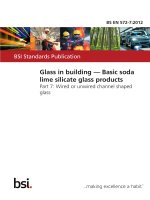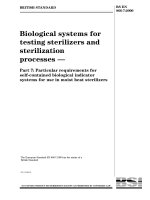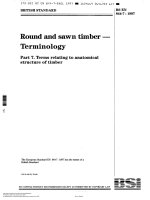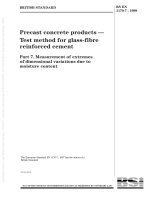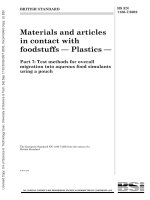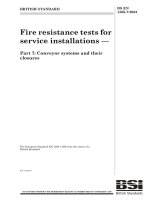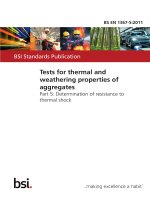Bsi bs en 62047 7 2011
Bạn đang xem bản rút gọn của tài liệu. Xem và tải ngay bản đầy đủ của tài liệu tại đây (1.33 MB, 34 trang )
BS EN 62047-7:2011
BSI Standards Publication
Semiconductor devices —
Micro-electromechanical
devices
Part 7: MEMS BAW filter and duplexer for
radio frequency control and selection
NO COPYING WITHOUT BSI PERMISSION EXCEPT AS PERMITTED BY COPYRIGHT LAW
raising standards worldwide™
BS EN 62047-7:2011
BRITISH STANDARD
National foreword
This British Standard is the UK implementation of EN
62047-7:2011. It is identical to IEC 62047-7:2011.
The UK participation in its preparation was entrusted to Technical
Committee EPL/47, Semiconductors.
A list of organizations represented on this committee can be
obtained on request to its secretary.
This publication does not purport to include all the necessary
provisions of a contract. Users are responsible for its correct
application.
© BSI 2011
ISBN 978 0 580 60628 1
ICS 31.080.99
Compliance with a British Standard cannot confer immunity from
legal obligations.
This British Standard was published under the authority of the
Standards Policy and Strategy Committee on 31 August 2011.
Amendments issued since publication
Date
Text affected
BS EN 62047-7:2011
EUROPEAN STANDARD
EN 62047-7
NORME EUROPÉENNE
August 2011
EUROPÄISCHE NORM
ICS 31.080.99
English version
Semiconductor devices Micro-electromechanical devices Part 7: MEMS BAW filter and duplexer for radio frequency control and
selection
(IEC 62047-7:2011)
Dispositifs à semiconducteurs Dispositifs microélectromécaniques Partie 7: Filtre et duplexeur BAW MEMS
pour la commande et le choix des
fréquences radioélectriques
(CEI 62047-7:2011)
Halbleiterbauelemente Bauelemente der Mikrosystemtechnik Teil 7: BAW-MEMS-Filter und -Duplexer
zur Hochfrequenz-Regelung und -Auswahl
(IEC 62047-7:2011)
This European Standard was approved by CENELEC on 2011-07-21. CENELEC members are bound to comply
with the CEN/CENELEC Internal Regulations which stipulate the conditions for giving this European Standard
the status of a national standard without any alteration.
Up-to-date lists and bibliographical references concerning such national standards may be obtained on
application to the Central Secretariat or to any CENELEC member.
This European Standard exists in three official versions (English, French, German). A version in any other
language made by translation under the responsibility of a CENELEC member into its own language and notified
to the Central Secretariat has the same status as the official versions.
CENELEC members are the national electrotechnical committees of Austria, Belgium, Bulgaria, Croatia, Cyprus,
the Czech Republic, Denmark, Estonia, Finland, France, Germany, Greece, Hungary, Iceland, Ireland, Italy,
Latvia, Lithuania, Luxembourg, Malta, the Netherlands, Norway, Poland, Portugal, Romania, Slovakia, Slovenia,
Spain, Sweden, Switzerland and the United Kingdom.
CENELEC
European Committee for Electrotechnical Standardization
Comité Européen de Normalisation Electrotechnique
Europäisches Komitee für Elektrotechnische Normung
Management Centre: Avenue Marnix 17, B - 1000 Brussels
© 2011 CENELEC -
All rights of exploitation in any form and by any means reserved worldwide for CENELEC members.
Ref. No. EN 62047-7:2011 E
BS EN 62047-7:2011
EN 62047-7:2011
-2-
Foreword
The text of document 47F/79/FDIS, future edition 1 of IEC 62047-7, prepared by SC 47F, Microelectromechanical systems, of IEC TC 47, Semiconductor devices, was submitted to the IEC-CENELEC
parallel vote and was approved by CENELEC as EN 62047-7 on 2011-07-21.
Attention is drawn to the possibility that some of the elements of this document may be the subject of
patent rights. CEN and CENELEC shall not be held responsible for identifying any or all such patent
rights.
The following dates were fixed:
– latest date by which the EN has to be implemented
at national level by publication of an identical
national standard or by endorsement
(dop)
2012-04-21
– latest date by which the national standards conflicting
with the EN have to be withdrawn
(dow)
2014-07-21
__________
Endorsement notice
The text of the International Standard IEC 62047-7:2011 was approved by CENELEC as a European
Standard without any modification.
In the official version, for Bibliography, the following notes have to be added for the standards indicated:
IEC 60368-1:2000
+ A1:2004
NOTE Harmonized as EN 60368-1:2000 + A1:2004 (not modified).
IEC 60368-2-2
NOTE Harmonized as EN 60368-2-2.
IEC 60862-1:2003
NOTE Harmonized as EN 60862-1:2003 (not modified).
IEC 60862-2
NOTE Harmonized as EN 60862-2.
__________
BS EN 62047-7:2011
–2–
62047-7 IEC:2011
CONTENTS
FOREWORD ........................................................................................................................... 4
1
Scope ............................................................................................................................... 6
2
Normative references ....................................................................................................... 6
3
Terms and definitions ....................................................................................................... 6
3.1
3.2
3.3
3.4
4
General terms ......................................................................................................... 6
Related with BAW filter ............................................................................................ 7
Related with BAW duplexer ..................................................................................... 9
Characteristic parameters ..................................................................................... 10
3.4.1 BAW resonator .......................................................................................... 10
3.4.2 BAW filter and duplexer ............................................................................. 13
3.4.3 Temperature characteristics ...................................................................... 16
Essential ratings and characteristic parameters .............................................................. 16
5
4.1 Resonator, filter and duplexer marking ................................................................. 16
4.2 Additional information ............................................................................................ 17
Test methods ................................................................................................................. 17
5.1
5.2
Test procedure ...................................................................................................... 17
RF characteristics ................................................................................................. 19
5.2.1 Insertion attenuation, IA ............................................................................. 19
5.2.2 Return attenuation, RA .............................................................................. 20
5.2.3 Bandwidth ................................................................................................. 21
5.2.4 Isolation .................................................................................................... 21
5.2.5 Ripple ........................................................................................................ 22
5.2.6 Voltage standing wave ratio (VSWR) ......................................................... 22
5.2.7 Impedances of input and output ................................................................. 23
5.3 Reliability test method ........................................................................................... 23
5.3.1 Test procedure .......................................................................................... 23
Annex A (informative) Geometries of BAW resonators ......................................................... 25
Annex B (informative) Operation of BAW resonators ............................................................ 26
Bibliography .......................................................................................................................... 28
Figure 1 – Basic structure of BAW resonator ........................................................................... 7
Figure 2 – Topologies for BAW filter design ............................................................................ 8
Figure 3 – Frequency responses of ladder and lattice type BAW filters ................................... 8
Figure 4 – An example of BAW duplexer configuration ............................................................ 9
Figure 5 – Equivalent circuit of BAW resonator (one-port resonator) ..................................... 10
Figure 6 – Measurement procedure of BAW filters and duplexers ......................................... 18
Figure 7 – Electrical measurement setup of BAW resonators, filters and duplexers ............... 19
Figure 8 – Insertion attenuation of BAW filter ........................................................................ 20
Figure 9 – Return attenuation of BAW filter ........................................................................... 21
Figure 10 – Isolation (Tx-Rx) of BAW duplexer ...................................................................... 22
Figure 11 – Ripple of BAW filter ............................................................................................ 22
Figure 12 – Smith chart plot of input and output impedances of BAW filter ............................ 23
Figure 13 – Block diagram of a test setup for evaluating the reliability of BAW
resonators and filters ............................................................................................................ 24
BS EN 62047-7:2011
62047-7 IEC:2011
–3–
Figure A.1 – Geometry comparison of BAW resonators ......................................................... 25
Figure B.1 – Modified BVD (Butterworth-Van Dyke) equivalent circuit model ......................... 27
BS EN 62047-7:2011
–4–
62047-7 IEC:2011
INTERNATIONAL ELECTROTECHNICAL COMMISSION
____________
SEMICONDUCTOR DEVICES –
MICRO-ELECTROMECHANICAL DEVICES –
Part 7: MEMS BAW filter and duplexer
for radio frequency control and selection
FOREWORD
1) The International Electrotechnical Commission (IEC) is a worldwide organization for standardization comprising
all national electrotechnical committees (IEC National Committees). The object of IEC is to promote
international co-operation on all questions concerning standardization in the electrical and electronic fields. To
this end and in addition to other activities, IEC publishes International Standards, Technical Specifications,
Technical Reports, Publicly Available Specifications (PAS) and Guides (hereafter referred to as “IEC
Publication(s)”). Their preparation is entrusted to technical committees; any IEC National Committee interested
in the subject dealt with may participate in this preparatory work. International, governmental and nongovernmental organizations liaising with the IEC also participate in this preparation. IEC collaborates closely
with the International Organization for Standardization (ISO) in accordance with conditions determined by
agreement between the two organizations.
2) The formal decisions or agreements of IEC on technical matters express, as nearly as possible, an international
consensus of opinion on the relevant subjects since each technical committee has representation from all
interested IEC National Committees.
3) IEC Publications have the form of recommendations for international use and are accepted by IEC National
Committees in that sense. While all reasonable efforts are made to ensure that the technical content of IEC
Publications is accurate, IEC cannot be held responsible for the way in which they are used or for any
misinterpretation by any end user.
4) In order to promote international uniformity, IEC National Committees undertake to apply IEC Publications
transparently to the maximum extent possible in their national and regional publications. Any divergence
between any IEC Publication and the corresponding national or regional publication shall be clearly indicated in
the latter.
5) IEC itself does not provide any attestation of conformity. Independent certification bodies provide conformity
assessment services and, in some areas, access to IEC marks of conformity. IEC is not responsible for any
services carried out by independent certification bodies.
6) All users should ensure that they have the latest edition of this publication.
7) No liability shall attach to IEC or its directors, employees, servants or agents including individual experts and
members of its technical committees and IEC National Committees for any personal injury, property damage or
other damage of any nature whatsoever, whether direct or indirect, or for costs (including legal fees) and
expenses arising out of the publication, use of, or reliance upon, this IEC Publication or any other IEC
Publications.
8) Attention is drawn to the Normative references cited in this publication. Use of the referenced publications is
indispensable for the correct application of this publication.
9) Attention is drawn to the possibility that some of the elements of this IEC Publication may be the subject of
patent rights. IEC shall not be held responsible for identifying any or all such patent rights.
International Standard IEC 62047-7 has been prepared by subcommittee 47F: Microelectromechanical systems, of IEC technical committee 47: Semiconductor devices.
The text of this standard is based on the following documents:
FDIS
Report on voting
47F/79/FDIS
47F/87/RVD
Full information on the voting for the approval of this standard can be found in the report on
voting indicated in the above table.
This publication has been drafted in accordance with the ISO/IEC Directives, Part 2.
BS EN 62047-7:2011
62047-7 IEC:2011
–5–
The committee has decided that the contents of this publication will remain unchanged until
the stability date indicated on the IEC web site under "" in the data
related to the specific publication. At this date, the publication will be
•
•
•
•
reconfirmed,
withdrawn,
replaced by a revised edition, or
amended.
IMPORTANT – The “colour inside” logo on the cover page of this publication indicates
that it contains colours which are considered to be useful for the correct understanding
of its contents. Users should therefore print this publication using a colour printer.
BS EN 62047-7:2011
–6–
62047-7 IEC:2011
SEMICONDUCTOR DEVICES –
MICRO-ELECTROMECHANICAL DEVICES –
Part 7: MEMS BAW filter and duplexer
for radio frequency control and selection
1
Scope
This part of IEC 62047 describes terms, definition, symbols, configurations, and test methods
that can be used to evaluate and determine the performance characteristics of BAW resonator,
filter, and duplexer devices as radio frequency control and selection devices. This standard
specifies the methods of tests and general requirements for BAW resonator, filter, and
duplexer devices of assessed quality using either capability or qualification approval
procedures.
2
Normative references
Void.
3
Terms and definitions
For the purposes of this document, the following terms and definitions apply.
3.1
General terms
3.1.1
bulk acoustic wave
BAW
acoustic wave propagating in a bulk body
3.1.2
BAW resonator
resonator employing bulk acoustic wave
NOTE BAW resonator consists of piezoelectric material between top and bottom electrodes, as shown in Figure 1.
The top and bottom electrodes which can be made to vibrate in a vertical direction of the deposited piezoelectric
film. The electrodes are either two air-to-solid interfaces or an acoustic Bragg reflector and an air-to-solid interface.
The former is often called the film bulk acoustic resonator (FBAR), and the latter is called the solidly-mounted
resonator (SMR).
BS EN 62047-7:2011
62047-7 IEC:2011
–7–
Electrode
Air-to-solid
interface
Piezoelectric film
AC power
supply
IEC 1211/11
Key
Layers of a piece of BAW resonator
Electrode
To provide electrical input to a body of
piezoelectric film and electrical connections
with a external circuit
Piezoelectric
film
Body layer of a kind of BAW resonator
Components to operate a BAW resonator
AC power
supply
Electric power supply to vibrate a
BAW resonator
Air to solid
interface
Figure 1 – Basic structure of BAW resonator
3.1.3
electrode
electrically conductive plate in proximity to or film in contact with a face of the piezoelectric
film by means of which a polarizing or driving field is applied to the element
[IEC/TS 61994-1, 3.21]
3.1.4
piezoelectric film
film which has piezoelectricity
NOTE Piezoelectric films can be distinguished as non-ferroelectric and ferroelectric materials. The nonferroelectric materials, such as AlN (aluminium nitride) and ZnO (zinc oxide) have low dielectric constant, small
dielectric loss, good hardness, and excellent insulating properties. Thus, they are good for microwave resonator
and filter applications. The ferroelectric materials, such as PZT (lead-zirconate-titanate) and PLZT (leadlanthanum-zirconate) have high dielectric constant, large dielectric loss, and fair insulating properties. Thus, they
are good for memory and actuator applications.
3.1.5
direct piezoelectric effect
effect which a mechanical deformation of piezoelectric material produces a proportional
change in the electric polarization of that material
3.1.6
converse (or reverse) piezoelectric effect
effect which mechanical stress proportional to an acting external electric field is induced in
the piezoelectric material
NOTE Converse piezoelectric effect is widely being used for acoustic wave resonators and filters, resonant
sensors, oscillators, ultrasonic wave generators, and actuators. Direct piezoelectric effect is usually applied for
various piezoelectric sensors and voltage generators.
3.2
Related with BAW filter
Figure 2 shows topologies for BAW filter design.
BS EN 62047-7:2011
–8–
62047-7 IEC:2011
IEC 1212/11
IEC 1213/11
a) Ladder type
b) Lattice type
Figure 2 – Topologies for BAW filter design
NOTE BAW resonators are connected in series and parallel for forming electrical filters, as shown in Figure 2.
The resonant frequencies of series and parallel resonators should be different to secure the bandwidth of the BAW
filter.
3.2.1
ladder filter
filter having a cascade or tandem connection of alternating series and shunt BAW resonators
Insertion attenuation (dB)
Insertion attenuation (dB)
NOTE BAW resonator connected in series should have slightly higher resonant frequency than that of a parallel
BAW resonator. The parallel resonant frequency of the parallel BAW resonator needs to be equal to the series
resonant frequency of the series BAW resonator in the filter geometry shown in Figure 2. It gives a steep roll-off,
but poor stop-band rejection characteristics as shown in Figure 3a). Thus, helper inductors are usually given to
improve the isolation, and in general, the out-of-band rejection far from the passband becomes worse.
Frequency
Frequency
IEC 1214/11
a) Ladder type
IEC 1215/11
b) Lattice type
Figure 3 – Frequency responses of ladder and lattice type BAW filters
3.2.2
lattice filter
filter having two pairs of resonators electrically coupled in a bridge network, with one pair of
resonators in a series arm and the other pair in a shunt arm
[IEC 60862-1: 2003, 2.2.3.8 modified]
NOTE Lattice type filter need more resonators than ladder type one, sine it needs two resonators to synthesize
one pole and one transmission zero from the transfer function. The pass-band is obtained when one pair of
resonators behaves inductive while the other pair of resonators behaves capacitive. Unlike the ladder type filter, it
gives a deep stop-band rejection and good power handling capability, but smooth roll-off characteristics as shown
in Figure 3 b).
BS EN 62047-7:2011
62047-7 IEC:2011
–9–
3.2.3
helper inductor
inductor connected with shunt resonators of ladder BAW filter
3.3
Related with BAW duplexer
Figure 4 shows an example of BAW duplexer configuration.
Tx
BAW filter
Ant
Rx
TLphase
IEC 1216/11
Key
Tx
transmitting port
Rx
receiving port
Ant
antenna port
TL phase
phase delay line
Figure 4 – An example of BAW duplexer configuration
NOTE Two different BAW filters, transmitting and receiving band pass filters, are connected with a quarter
wavelength phase shifter, phase delay line, or parallel inductor on a package substrate for forming a duplexer, as
shown in Figure 4. In order to improve isolation characteristics between these transmitting and receiving filters, via
grounds should be well formed onto the package substrate. Series and shunt inductors are added into the Tx and
Rx filters in order to improve its attenuation, roll-off, and ripple characteristics.
3.3.1
transmitting band pass filter
Tx
band pass filter used at the transmitter of the RF system which transmits a signal to the
antenna
3.3.2
receiving band pass filter
Rx
band pass filter used at the receiver of the RF system which receives a signal from the
antenna
3.3.3
phase delay line
transmission line to delay a signal from a port to the antenna or isolate the transmitter and
receiver
BS EN 62047-7:2011
– 10 –
3.4
3.4.1
62047-7 IEC:2011
Characteristic parameters
BAW resonator
3.4.1.1
equivalent circuit (of BAW resonators)
electrical circuit which has the same impedance as a piezoelectric resonator in the immediate
neighborhood of resonance
NOTE For example, one port BAW resonator consists of series elements L m , C m , R m in parallel with C o as shown
in Figure 5, where L m , C m , R m represent the motional inductance, capacitance, and resistance, respectively. C o
represents the shunt capacitance. Sometimes, another resistance R s is added in series with an input terminal for
taking account of electrode and interconnection resistance.
Co
Rm
Cm
Lm
IEC 1217/11
Key
C0
shunt capacitance
Rm
motional resistance
Cm
motional capacitance
Lm
motional inductance
Figure 5 – Equivalent circuit of BAW resonator (one-port resonator)
[IEC/TS 61994-1: 2007, 3.25 modified]
3.4.1.2
nominal frequency
frequency assigned by the specification of the resonator
[IEC/TS 61994-1: 2007, 3.58 modified]
3.4.1.3
resonant frequency (or series resonant frequency)
fr
lower frequency of the two frequencies of a piezoelectric resonator vibrating alone under
specified conditions, at which the electrical impedance of the resonator is resistive
[IEC/TS 61994-1: 2007, 3.81 modified]
3.4.1.4
anti-resonant frequency (parallel resonant frequency, f p )
fa
the higher frequency of two frequencies of a piezoelectric resonator vibrating alone. An
approximate value of this frequency is given by the expression
f p = 1 / 2π LmCmC0 /(Cm + C0 )
where
C 0 represents the shunt capacitance; and
(1)
BS EN 62047-7:2011
62047-7 IEC:2011
– 11 –
L m and C m are the motional inductance and capacitance
[IEC/TS 61994-1: 2007, 3.3, 3.69 modified]
3.4.1.5
motional (series) resonant frequency
fs
resonant frequency of the motional or series arm of the equivalent circuit of the resonator, it is
defined by the following formula
fs =
1
2π LmCm
(2)
where
Lm
and
Cm represent the motional inductance and capacitance respectively .
[IEC/TS 61994-1: 2007, 3.55 modified]
3.4.1.6
fundamental resonance
lowest resonance mode in a given family of vibration
3.4.1.7
spurious resonance
state of resonance of a resonator other than that associated with the working frequency
[IEC/TS 61994-1: 2007, 3.86 modified]
3.4.1.8
spurious resonance rejection level
difference between the maximum level of spurious resonances and the minimum insertion
attenuation
[IEC/TS 61994-1: 2007, 3.87 modified]
3.4.1.9
unwanted response
state of resonance of a resonator other than that associated with the mode of vibration
intended for the application
[IEC/TS 61994-1: 2007, 3.99 modified]
3.4.1.10
capacitance ratio
r
ratio of the parallel capacitance C 0 to the motional capacitance C m
[IEC/TS 61994-1: 2007, 3.7 modified]
3.4.1.11
motional capacitance
Cm
capacitance of the motional or series arm of the resonator equivalent circuit
BS EN 62047-7:2011
– 12 –
62047-7 IEC:2011
3.4.1.12
motional inductance
Lm
inductance of the motional or series arm of the resonator equivalent circuit
3.4.1.13
motional resistance
Rm
resistance of the motional or series arm of the resonator equivalent circuit
[IEC/TS 61994-1: 2007, 3.52 modified]
3.4.1.14
shunt capacitance
C0
capacitance in parallel with the motional arm of the resonator equivalent circuit which is
caused by the energy leakage and dielectric loss of the piezoelectric film
3.4.1.15
figure of merit
FOM or M
factor indicating performance of the device, product of both k eff 2 and Q, which indicates the
activity of the resonator, and the value usually given by Q/r, where Q is the Q factor and r is
the ratio of capacitances at low frequencies
[IEC/TS 61994-1: 2007 modified]
3.4.1.16
electromechanical coupling factor
certain combination of elastic, dielectric and piezoelectric constants which appears naturally
in the expression of impedance of a resonator. A different factor arises in each particular
family of mode of vibration. The factor is closely related to the relative frequency spacing and
is a convenient measure of piezoelectric transduction. Alternatively, the coupling factor may
be interpreted as the square root of the ratio of the electrical or mechanical work which can
be accomplished to the total energy stored from a mechanical or electrical power source for a
particular set of boundary conditions
[IEC/TS 61994-1: 2007, 3.22 modified]
3.4.1.17
relative frequency spacing
Bs
ratio of the difference between the parallel resonance frequency f p and the series resonance
frequency f s in a given mode of vibration, to the series resonance frequency
Bs = ( f p − f s ) / f p
(3)
[IEC TS61994-1: 2007, 3.80 modified]
3.4.1.18
effective electromechanical coupling factor
k eff 2
the effective electromechanical coupling factor for thickness-longitudinal vibration is defined
as follows:
π f r π f r
2
/ tan
k eff
=
2 f a 2 f a
(4)
BS EN 62047-7:2011
62047-7 IEC:2011
– 13 –
when the piezoelectric film is mechanically isolated from surroundings such as electrodes
3.4.1.19
electromechanical coupling factor (of piezoelectric material)
K2
figure indicating piezoelectric strength of piezoelectric material is defined as follows:
2
k eff
=
NOTE
K2
1+ K 2
(
)
(5)
It depends not only materials but also the wave type and the wave propagation direction and polarization.
3.4.1.20
quality factor (for a series resonant circuit of BAW resonator)
Q
factor how long stored energy is preserved in a device and is defined as follows:
Q = 2πf r Lm / Rm
(6)
where
fr
is the resonance frequency;
Lm
is the motional inductance;
Rm
is the motional resistance
[IEC/TS61994-1: 2007, 3.77 modified]
NOTE The Q of a resonator is a measure of the losses in the device. The possible dissipative losses are
resistances in the electrodes, visco-acoustic loss in all of the materials, acoustic scattering from rough surfaces or
material defects, and acoustic radiation into the surrounding areas of the BAW device.
3.4.1.21
long-term parameter variation
relationship which exists between any parameter (for example resonance frequency) and time
3.4.2
BAW filter and duplexer
3.4.2.1
shape factor
ratio of the two bandwidths limited by two specified attenuation value
3.4.2.2
transition band
band of frequencies between a cut-off frequency and the nearest point of the adjacent stop
band
3.4.2.3
roll off rate
ratio of transition band to the ideal cut off frequency, which is an index describing the
increasing characteristics of BAW filters
3.4.2.4
attenuation
decrease in intensity of a signal, beam, or wave as a result of absorption of energy and of
scattering out of the path to the detector, but not including the reduction due to geometric
spreading
BS EN 62047-7:2011
– 14 –
62047-7 IEC:2011
3.4.2.5
insertion attenuation
IA
logarithmic ratio of the power delivered to the load impedance before and after insertion of the
filter and duplexer
3.4.2.5.1
minimum insertion attenuation
minimum value of insertion attenuation in the pass band
3.4.2.5.2
nominal insertion attenuation
insertion attenuation at a specified reference frequency
3.4.2.5.3
maximum insertion attenuation
maximum value of insertion attenuation in the pass band
3.4.2.6
relative attenuation
difference between the attenuation at a given frequency and the attenuation at the reference
frequency
3.4.2.7
return attenuation
RA
value of the reciprocal of modulus of the reflection coefficient, expressed in decibels.
Quantitatively, it is equal to Lr , where Z1 is the impedance toward the source and Z 2 is the
impedance toward the load, and the vertical bars indicate magnitude. It is the ratio of the
reflected power to the incident power. Γ is a reflection coefficient.
Lr = 20 log
Z1 + Z 2
[dB]
Z1 − Z 2
RA = 20 log(Γ ) [dB]
(7)
(8)
[IEC/TS 61994-2: 2000, 3.47 modified]
3.4.2.8
isolation
ratio of original signal power versus unwanted signal power when T x signals go through the
antenna and the unwanted T x signals come out from R x port. Isolation usually concentrates
between T x and R x ports
3.4.2.9
ripple (pass-band ripple)
difference between the maximum and minimum attenuation within a pass band
3.4.2.10
pass-band attenuation deviation
maximum variation of the attenuation within a defined portion of the pass band of a filter
3.4.2.11
nominal frequency
frequency given by the manufacturer or the specification to identify the filter and duplexer
BS EN 62047-7:2011
62047-7 IEC:2011
– 15 –
3.4.2.12
center frequency
frequency of the middle in the pass band or arithmetic mean of the cut-off frequencies
3.4.2.13
cut-off frequency
frequency of the pass band at which the relative attenuation reaches a specified value
3.4.2.14
pass band
band of frequencies in which the relative attenuation is equal to or less than a specified value
3.4.2.15
pass bandwidth
separation of frequencies between which the attenuation of a piezoelectric filter shall be equal
to, or less than, a specified value
3.4.2.16
stop band
band of frequencies in which the relative attenuation is equal to or greater than a specified
value
3.4.2.17
stop bandwidth
separation of frequencies between which the relative attenuation is equal to or greater than a
specified value
3.4.2.18
fractional or relative bandwidth
ratio of the pass bandwidth to the mid-band frequency in the case of band-pass fitter or ratio
of the stop bandwidth to the mid-band frequency in the case of band-stop filter
[IEC/TS 61994-2: 2000, 3.13 modified]
3.4.2.19
selectivity
difference between the attenuation at the given frequency outside the pass-band and the
reference value at a given reference frequency
3.4.2.20
standing wave
formed wave when an electromagnetic wave is transmitted into one end of a transmission line
and is reflected from the other end by an impedance mismatch
3.4.2.21
standing wave ratio
ratio of the amplitude of a standing wave at an anti-node (minimum) to the amplitude at an
adjacent node (maximum) or ratio of the electrical field strength at a voltage maximum on a
transmission line to the electrical field strength of an adjacent voltage minimum
3.4.2.22
impedance
total passive opposition offered to the flow of electric current. It is determined by the
particular combination of resistance, inductive reactance, and capacitive reactance in a given
circuit. It is represented by the letter "Z" and measured in ohms
BS EN 62047-7:2011
– 16 –
62047-7 IEC:2011
3.4.2.23
input impedance
impedance at the input terminal of the filter device when it is properly terminated at its output
3.4.2.24
output impedance (or load impedance)
impedance presented by the filter to the load when the input is terminated by a specified
source impedance
3.4.2.25
characteristic impedance
ratio of the complex voltage applied to the input of an infinitely long transmission line to the
complex current that would flow in that line
3.4.2.26
RF power handling capability
capability of the filter or duplexer to transmit a given amount of power through the device
3.4.2.27
envelop delay time
time of propagation of a certain characteristic of a signal envelope between two points for a
certain frequency
3.4.2.28
operating temperature range
range of temperatures as measured on the enclosure over which the resonator will not sustain
permanent damage though not necessarily functioning within the specified tolerances
3.4.3
Temperature characteristics
3.4.3.1
temperature characteristics of mid-band frequency
maximum reversible variation of mid-band frequency produced over a given temperature
range within the category temperature range. It is expressedo normally as a percentage of the
mid-band frequency related to a reference temperature of 25 C
3.4.3.2
temperature coefficient of mid-band frequency
TCF
rate of change of mid-band frequency with the temperature measured over a specified
range
o
of temperature. It is normally expressed in parts per million per degree Celsius (10 -6 / C)
4
4.1
Essential ratings and characteristic parameters
Resonator, filter and duplexer marking
Bulk acoustic wave resonators, filters and duplexers shall be clearly and durably marked in
the order given below:
a)
year and week (or month) of manufacture;
b)
manufacture’s name or trade mark;
c)
terminal identification (optional);
d)
serial number;
e)
factory identification code (optional).
BS EN 62047-7:2011
62047-7 IEC:2011
4.2
– 17 –
Additional information
Some additional information should be given such as equivalent input and output circuits (eg.
input/output impedance, characteristic impedance, etc.), handling precautions, physical
information (eg. outline dimensions, terminals, accessories, etc.), package information, PCB
interface and mounting information, and other information, etc.
5
5.1
Test methods
Test procedure
Basically, test procedures for d.c. characteristics and RF characteristics of BAW filters and
duplexers are performed as shown in Figure 6 and Figure 7. The packaged BAW filters and
duplexers are mounted on a test fixture and measured by using a network analyzer. Since the
impedance of the network analyzer is usually 50 Ω the termination condition between the
filter and the equipment should be considered carefully.
Before connecting the filter or duplexer test fixture, the network analyzer, cable, and
connectors should be calibrated. The full 2-port calibration technique is effective to
compensate the system errors (i.e. presenting open-circuit impedance, short-circuit
impedance, through standards at the ends of test cable connectors, 50 Ω load impedance,
and storing the measured values for correction of resonator, filter, and duplexer
measurement). After calibration, connect the test cable with the filter test fixture with 50 Ω
connectors. The reading of s-parameter on the display of the network analyzer is taken. A
reflection coefficient, S11 and a transmission coefficient, S21 of two-port S parameters are
translated into reflection attenuation and insertion attenuation, respectively. If a different
frequency range is required, the entire calibration sequence has to be repeated.
BS EN 62047-7:2011
– 18 –
62047-7 IEC:2011
Start
Insertion attenuation
Ripple
Return attenuation
RF characterization
VSWR
Bandwidth
Input and output
impedance
Isolation
Power handling
capability
Temperature
test
Reliability
End
IEC 1218/11
Key
Name of procedure
Reference subclause
Name of procedure
Reference subclause
Start
Temperature test
5.3.1.2
RF characterization
Insertion attenuation
3.4.2.5 and 5.2.1
Reliability
Return attenuation
3.4.2.7 and 5.2.2
End
Bandwidth
3.4.2.15 and 5.2.3
Ripple
3.4.2.9 and 5.2.5
Isolation
3.4.2.8 and 5.2.4
VSWR
5.2.6 Voltage standing
wave ratio
Power handling
capability
5.3.1.1
Input and output
impedance
3.4.3.2.3 and 3.4.2.2.4
NOTE BAW filters and duplexers can be measured as shown in Figure 7. After mounting the BAW devices onto a
test fixture, RF characteristics are measured by using a network analyzer or an equivalent equipment. If the
measurements are satisfactory, reliability test (temperature (thermal cycling), shock, RF power handling, etc.) is
performed for commercially use.
Figure 6 – Measurement procedure of BAW filters and duplexers
BS EN 62047-7:2011
62047-7 IEC:2011
– 19 –
Network analyzer
AC
power source
A
Port 1
Transfer switch
Reference
channel
B
Port 2
C
Port 3
D
Port 4
Test cable
50 Ω
Test cable
DUT
Test cable
IEC 1219/11
Key
Components and meters to monitor
Equipments and supplies
DUT: device
under test
A piece of BAW resonator or
BAW filter or BAW duplexer
AC power source:
To supply a specified level of electric
power to a type of transfer switch
A (channel):
To detect port 1 reflected from
the input of a piece of DUT
Transfer switch:
To transfer a specified input power by
switching toward port 1 or port 2
B (channel):
To detect port 2 reflected from
the input of a piece of DUT
Test cable:
C (channel):
To detect port 3 reflected from
the input of a piece of DUT
Network analyzer:
D (channel):
To detect port42 power
transmitted through the DUT
Reference
channel
(meter):
To detect supplying electric
power in watts to keep a
specified level
To measure S-parameters through a
piece of DUT
NOTE Other filter test equipments can also be used instead of the network analyzer. In case of BAW duplexers,
unused port should be terminated with 50 Ω or 75 Ω during the measurement.
Figure 7 – Electrical measurement setup of BAW resonators, filters and duplexers
5.2
5.2.1
RF characteristics
Insertion attenuation, IA
When the incident power is applied to input port of the band-pass filter or duplexer, it is a
measured ratio between the transmitted power to the output port and the incident power. The
insertion attenuation of the band-pass filter is obtained from the measured S-parameter - S 21 .
The insertion attenuations of the duplexer are obtained from the measured S-parameter - S 13
(Tx-Ant) and S 32 (Ant-Rx). The insertion attenuation is normally expressed in decibels (dB)
and obtained by the following equation.
BS EN 62047-7:2011
– 20 –
62047-7 IEC:2011
IA = −20 log( S 21 ) = 20 log( Γ ) [dB]
(9)
The measured insertion attenuation of the band-pass filter or duplexer should be lower than
required minimum insertion attenuation given by users at the frequency band of applications.
Figure 8 shows the graphical shape of the measured insertion attenuation.
Insertion attenuation (dB)
0
10
20
30
40
50
1,70
1,75
1,80
1,85
1,90
1,95
2,00
Frequency (GHz)
2,05
2,10
IEC 1220/11
Figure 8 – Insertion attenuation of BAW filter
5.2.2
Return attenuation, RA
It is the measured ratio, normally expressed in dB, of the reflected power to the incident
power. It is obtained from the measured S-parameter, S 11 in the band-pass filter.
RA = −20 log S11 = 20 log Γ [dB]
(10)
In the case of the duplexer, return attenuations are obtained from the measured S-parameters,
S 11 (for Tx band) and S 22 (for Rx band). Figure 9 shows the graphical shape of the measured
return attenuation. The return attenuation is normally expressed in decibels (dB)
BS EN 62047-7:2011
62047-7 IEC:2011
– 21 –
0
Return attenuation (dB)
5
10
15
20
25
30
1,70
1,75
1,80
1,85
1,90
1,95
2,00
Frequency (GHz)
2,05
2,10
IEC 1221/11
Figure 9 – Return attenuation of BAW filter
5.2.3
Bandwidth
It is the working frequency range of the band-pass filter or duplexer having good RF
characteristics enough to be used in subsystems and system applications. It is the measured
range, normally expressed in Hz, of the separation between the lower and the upper relative
to the specified value of the frequency response curve.
BW = f upper (specified ) − f lower (specified )Hz
(11)
It is obtained from the measured S-parameters – S 21 (band-pass filter), S 31 (Tx-Ant for
duplexer) and S 32 (Ant-Rx for duplexer). The upper and lower frequencies are selected when
the relative attenuation reaches a specified value.
5.2.4
Isolation
RF energy may leak from one conductor to another by radiation, ionization, capacitive
coupling, or inductive coupling. In case of duplexer, isolation is the measurement of the power
level between a transmitting, Tx and a receiving, Rx ports after terminating an antenna port as
50 Ω . Isolation is normally specified in dB below the Input power level.
Isolation = −20 log S 21 [dB]
(12)
The measured isolation of BAW duplexer should be higher than the required isolation given by
users. Figure 10 shows the graphical shape of the measured isolation characteristics.
BS EN 62047-7:2011
– 22 –
62047-7 © IEC:2011
20
Isolation (dB)
30
40
Rx band
50
Tx band
60
70
80
1,82 1,84 1,86 1,88 1,90 1,92 1,94 1,96 1,98 2,00 2,02
Frequency (GHz)
IEC 1222/11
Figure 10 – Isolation (Tx-Rx) of BAW duplexer
5.2.5
Ripple
In-band ripple is defined as the fluctuation of the insertion attenuation within the pass band.
Figure 11 shows the graphical shape of the measured ripple characteristics.
Insertion
attenuation
(dB) (dB)
Insertion
Attenuation
0
0
Ripple
Ripple
1
1
2
2
3
3
4
4
Passband
band
Pass
5
5
1.83 1,84
1.84 1,85
1.85
1,83
1.86
1,86
1.87
1,87
1.88
1,88
1.89 1,90
1.90
1,89
Frequency
(GHz)
Frequency (GHz)
1.91 1,92
1.92
1,91
1.93
1,93
IEC 1223/11
Figure 11 – Ripple of BAW filter
5.2.6
Voltage standing wave ratio (VSWR)
It is the measured ratio of the electrical field strength at a voltage maximum on a transmission
line to the electrical field strength of an adjacent voltage minimum. It is a measure of
mismatch of a line.
⎛1+ Γ
VSWR = ⎜⎜
⎝1− Γ
⎞ Vmax
⎟=
⎟ V , Γ is a reflection coefficient.
min
⎠
(13)
